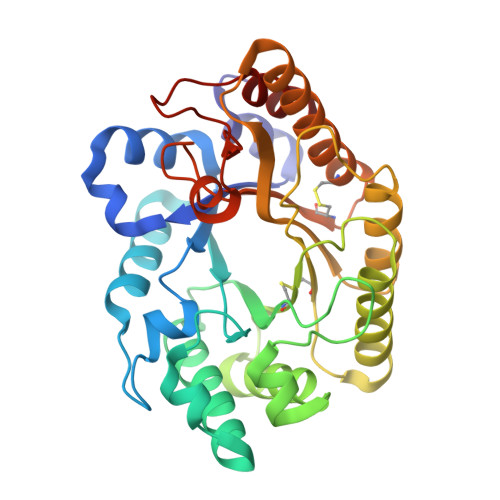Detailed structural analysis of glycosidase/inhibitor interactions: complexes of Cex from Cellulomonas fimi with xylobiose-derived aza-sugars.
Notenboom, V., Williams, S.J., Hoos, R., Withers, S.G., Rose, D.R.(2000) Biochemistry 39: 11553-11563
- PubMed: 10995222
- DOI: https://doi.org/10.1021/bi0010625
- Primary Citation of Related Structures:
1FH7, 1FH8, 1FH9, 1FHD - PubMed Abstract:
Detailed insights into the mode of binding of a series of tight-binding aza-sugar glycosidase inhibitors of two fundamentally different classes are described through X-ray crystallographic studies of complexes with the retaining family 10 xylanase Cex from Cellulomonas fimi. Complexes with xylobiose-derived aza-sugar inhibitors of the substituted "amidine" class (xylobio-imidazole, K(i) = 150 nM; xylobio-lactam oxime, K(i) = 370 nM) reveal lateral interaction of the "glycosidic" nitrogen with the acid/base catalyst (Glu127) and hydrogen bonding of the sugar 2-hydroxyl with the catalytic nucleophile (Glu233), as expected. Tight binding of xylobio-isofagomine (K(i) = 130 nM) appears to be a consequence of strong interactions of the ring nitrogen with the catalytic nucleophile while, surprisingly, no direct protein contacts are made with the ring nitrogen of the xylobio-deoxynojirimycin analogue (K(i) = 5800 nM). Instead the nitrogen interacts with two ordered water molecules, thereby accounting for its relatively weaker binding, though it still binds some 1200-fold more tightly than does xylobiose, presumably as a consequence of electrostatic interactions at the active site. Dramatically weaker binding of these same inhibitors to the family 11 xylanase Bcx from Bacillus circulans (K(i) from 0.5 to 1.5 mM) is rationalized for the substituted amidines on the basis that this enzyme utilizes a syn protonation trajectory and likely hydrolyzes via a (2,5)B boat transition state. Weaker binding of the deoxynojirimycin and isofagomine analogues likely reflects the energetic penalty for distortion of these analogues to a (2,5)B conformation, possibly coupled with destabilizing interactions with Tyr69, a conserved, catalytically essential active site residue.
Organizational Affiliation:
Protein Engineering Network of Centres of Excellence, Ontario Cancer Institute and Department of Medical Biophysics, University of Toronto, 610 University Avenue, Toronto, Ontario, Canada.
















